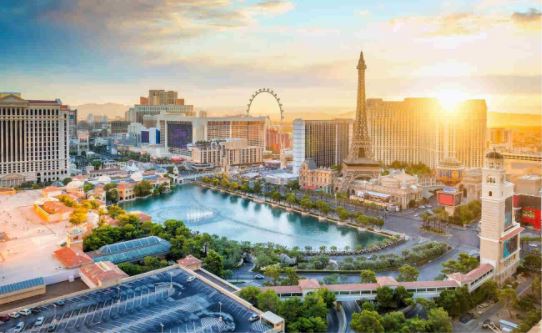Las Vegas: the city of glitz, glamour and gambling. It attracts visitors with its promise of riches, lavish hotels, unrivalled entertainment and, of course, lax marriage laws. This fascinating city went from isolated rest stop to burgeoning metropolis, but how did it grow into the casino wonderland it is today? Sin City’s history is more complex than you might think.
The discovery of the Las Vegas Springs
Situated in Clark County, Nevada, the city of Las Vegas has been in existence for over a hundred years. Long before it was the casino paradise that it is today, however, the area was home to Southern Nevada Native Americans — there’s evidence to suggest the Paiute tribe were there from 700 A.D. — and rock paintings speak of civilizations that existed in the area for as long as 10,000 years.
Las Vegas was built on a basin in the Mojave Desert. Before the land here turned arid, it was a lush, abundant wetland with vivid vegetation and ample water. Over time, the marsh receded, and so the desert was born. But the water had not left the land entirely — underground stores would occasionally rise to the surface to bring new life to the remaining plants. This led to a verdant, vivid magical oasis.
Up until the 19th century, it was believed that the Western World had not yet set foot here. That all changed when a Mexican explorer by the name of Antoni Armijo traveled the route from New Mexico to California—which would later be known as the Old Spanish Trail—with several companions. The caravan veered off the normal path and one of the party members, by the name of Rafael Rivera, left with a scouting party in search of water. Rivera broke off from the others and ventured solo into the desert where, by chance, he came upon the incredible, verdant oasis. And so, Las Vegas — Spanish for “the meadows” in tribute to thriving stretches of grass — was born. This was in 1829.
The beginnings of a gambling town
After the discovery of the Las Vegas Springs, the area was used as a rest stop for settlers (largely Mormon and Mexican) traveling the Old Spanish Trail to California. When the area moved from Mexican to American rule, a group of Mormons from Salt Lake City built a mini-town in order to protect a mail route, but they left the area by 1858.
It was many years later, in 1890, when railroad developers saw Las Vegas’s potential as the perfect stop in an already existing railroad route, as well the ability to then connect it to other major cities along the Pacific Coast. In 1905, the San Pedro was complete, and Las Vegas was now connected not only to the coast but the country’s main railways. This railroad shaped the history of Las Vegas and, ultimately, led to the mega-casino city it is today.
Once the railroad was finalised, the area completely transformed; houses, shops and bars shot up, and, on May 15, 1905, Las Vegas was officially founded. It was around this time that the man who owned the railroads, William A.Clark, auctioned off 1,200 lots in a day—today this exact area is known as Glitter Gulch (the name given to downtown Las Vegas, known for the dazzling neon lights and ample casinos).
Las Vegas becomes established as an entertainment hub
In the early 20th century, Las Vegas was primarily populated by railroad workers, travelers and ranchers. With its “Old West” charm came gambling, drinking and prostitutes — there was a clear general contempt and disregard for the law. Despite Nevada’s ban on gambling in 1910, illegal casinos and bars continued to thrive, and it wasn’t long before all the activity caught the attention of organised crime mobs looking to capitalise on the situation.
When the Hoover Dam was constructed in 1931, gambling was legalised once more. Thousands of construction workers headed to Las Vegas and mobsters and businessmen alike were eager to win their business. In a short amount of time, new casinos and entertainment venues were popping up along the only paved road in the city, Fremont Street (today known as the Glitter Gulch mentioned above). Despite the effects of the Second World War on business, El Rancho Vegas, the first Las Vegas hotel, opened in 1941 on Highway 91. This marked the beginning of what became known as the Las Vegas Strip.
The boom of the Las Vegas Strip
El Rancho Vegas became a hugely popular hotel and it caught the attention of mobsters who wanted a piece of the pie. Bugsy Siegel and Meyer Lansky built the iconic Flamingo Hotel, and set the standard for Las Vegas hotels with its Hollywood theme and glamorous design.
In the years that followed, the Riviera, the Sands and the Saraha (among others) were built mainly by mobsters funding their projects by illegal means. Eventually, more reputable investors were eager to be involved and Las Vegas was able to thrive. The Strip blossomed and the casino scene boomed. With huge celebrities performing on stages across Las Vegas (the likes of Elvis Presley, for example), tourists and eager gamers started arriving in droves.
The evolution of Las Vegas to the casino-centric city we know today
While it was the mob bosses who built so much of the initial Las Vegas, it was businessman and billionaire Howard Hughes who had a big hand in transforming that version of Las Vegas into what it is today. In 1966, Hughes stayed at the Desert Inn and decided to buy it. This set off a domino effect, with Hughes buying out a number of different hotels and eventually, by the 1980s, mob-owned hotels and casinos were a thing of the past.
Another huge shift in the Las Vegas casino scene came when Steve Wynn started designing and building mega-hotels. His Mirage hotel was the first luxury casino resort hotel in the city. This led to a huge transformation along the Strip and the introduction of massive developments inspired by the top cities across the world (the Eiffel Tower and Pyramid of Giza replicas say it all). With the introduction of these incredible casino resorts, Las Vegas even ventured into the “family holiday destination” category.
It wasn’t long before Las Vegas had some of the biggest resort hotels in the world. Today, the allure of Las Vegas is still its casinos and entertainment. It’s also a shopping paradise, a phenomenal golfing destination, and offers a range of fine-dining outlets for foodies. In short, this glittering city in the middle of the desert is a hedonistic destination unlike any other.
The introduction of online gaming
As technology has advanced, gaming has become easier and more accessible than ever before. You can simply lie in bed or on the couch and indulge in some sports betting, live casino games or online poker tournaments. Despite being the land-based gambler’s Holy Grail, Las Vegas has already started offering online casinos of their own and are working towards innovative gaming, with places like Bluetech Park pioneering some state-of-the-art technological offerings. Will the fabled Las Vegas casinos stay relevant? Perhaps — there are those who believe that there are certain things about live casinos that are irreplaceable, such as the social aspect, for example.
Regardless, a greater number of Las Vegas businesses are looking to integrate with technology in order to remain relevant, with some already offering VR arcades, virtual entertainment centres and lounge rooms, complete with VR headsets or augmented reality games. Perhaps as the immersive technologies of virtual and augmented reality evolve, more and more people will move away from the traditional casinos and move to online casino games. Only time will tell.
But why go all the way to Vegas to play online? If you’re eager to enjoy the Las Vegas lifestyle from the comfort of your own home, then head to Grosvenor Casinos and try your luck at the live casinos. At Grosvenor Casinos, you’ll find everything from live roulette and slots to a wealth of live casino games and more.


Leave a Reply